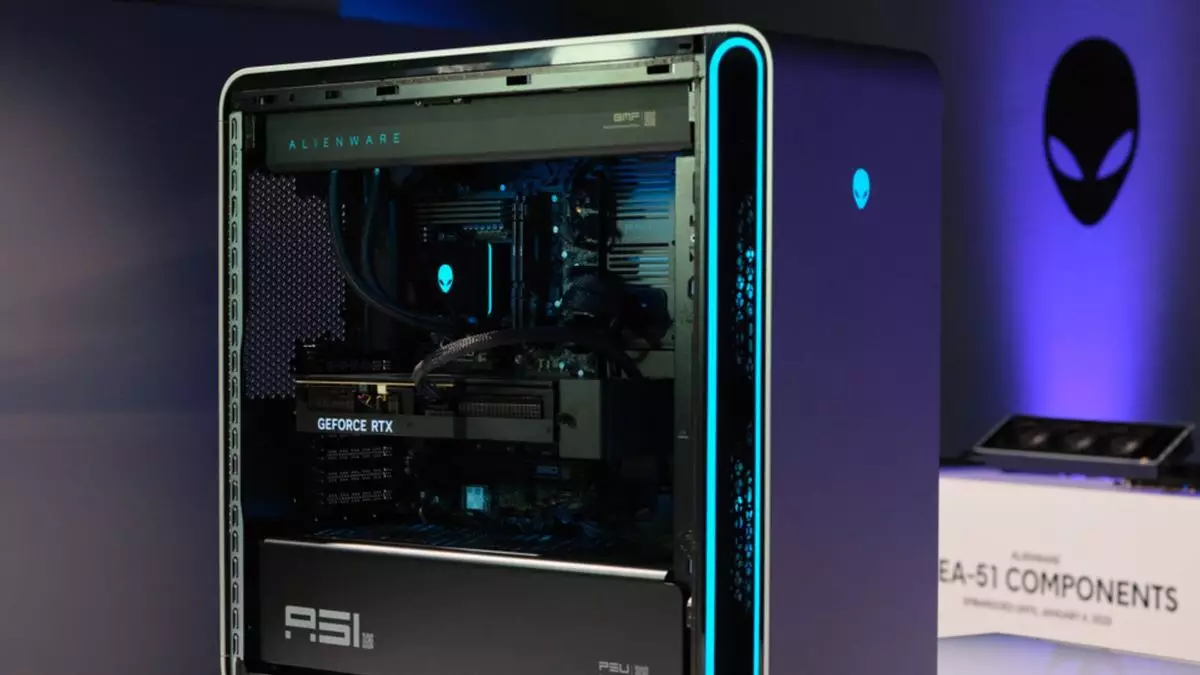Alienware has always been synonymous with high-performance gaming rigs, yet it has often been criticized for its limited options in terms of upgrades. This year, at CES, the renowned gaming brand hinted at a possible shift in its approach with the much-anticipated Area-51 desktop rig. However, lurking beneath the surface of this technological marvel lies a bittersweet caveat that raises questions about its true level of upgradeability.
The Upgrade Dilemma: An Asterisk?
The launch of the new Area-51 system comes with an enticing promise of enhanced upgradability—a feature that many tech enthusiasts have longed for. Yet, there is a catch: potential users must purchase a $35 AlienFX board cable conversion kit to achieve those lofty upgrade aspirations. This kit includes vital components such as a power switch wiring cable, a fan power bridge wiring cable, a USB dongle extension, and even a bag of nuts—a seemingly innocuous addition, yet essential for making the system fully functional with third-party motherboards.
The implication here is striking: while Alienware appears to be advancing toward a more modular future, the hidden costs associated with its “upgradeable” designation create an uncomfortable paradox. Should users really have to pay extra for something that should ideally come standard with a rig marketed for its upgradability? This situation reflects a deeper issue in the realm of premium technology: the subtle insertion of hidden costs that could leave a sour taste for many prospective buyers.
Connecting the Dots: Functionality and Compatibility
The conversion kit is engineered to “enable connectivity” between the Area-51 chassis and other motherboards, all while allowing users to employ exclusive features tied to the Alienware ecosystem, such as AlienFX lighting and enhanced fan controls. While the technology is undoubtedly impressive, existing customers of previous Area-51 versions might feel excluded, as the new conversion kit is incompatible with models predating the current release.
Imagine investing time and resources into an older Area-51 desktop, only to be told that your rig is now an obsolete relic with limited usability. It raises vital questions: How far should companies go to ensure compatibility across generations of gaming rigs? Or should the focus solely be on fostering innovation while sacrificing legacy support?
Performance Improvements: Hopes and Realities
Furthermore, the newly designed Area-51 rigs come loaded with the latest RTX 50 series graphics cards and boast powerful cooling technologies that offer better thermal efficiency and quieter operation. Boasting a revolutionary positive pressure airflow design aimed at preventing dust build-up, these systems have reportedly been improved to run up to 13% cooler and 45% quieter than their predecessors.
Yet, this performance enhancement is clouded by the limitations inherent in upgrading the motherboard. While users can still enjoy unrestrained upgrades of GPU, RAM, and SSD, the motherboard restriction signifies a significant compromise in modular design. What should be a robust build is instead tethered by the constraints of a decision that feels like a regression.
The Consumer’s Machine: An Unfinished Puzzle
The sense of disappointment deepens when enthusiasts consider the meticulous design aesthetic and practicality offered by the new Area-51 rigs. Each component is neatly labeled with QR codes, guiding users through the upgrade process. These thoughtful little touches accentuate an impressive rig that could easily captivate any gaming enthusiast.
However, by burdening users with additional costs that map out their upgrade journeys, Alienware creates an environment that feels anything but liberating. The excitement of having a modular system is dampened by the necessity of purchasing an add-on to unlock that very potential. This scenario leads to frustration and calls into question Alienware’s commitment to the gaming community that fueled its rise.
A Double-Edged Sword
In essence, the release of the new Area-51 desktop seems to symbolize a double-edged sword for Alienware. While the brand is undoubtedly making strides towards making its products more versatile and performance-oriented, the hidden costs and restrictions highlight an ongoing struggle between innovation and accessibility. Amidst the shiny branding and impressive specs lies an unmistakable tension that resonates with the very core of gaming culture—where creativity should thrive without additional barriers.
Alienware may indeed be turning a corner, but the lingering shadow of limited upgrade paths proves that progress is often a precarious balancing act.

